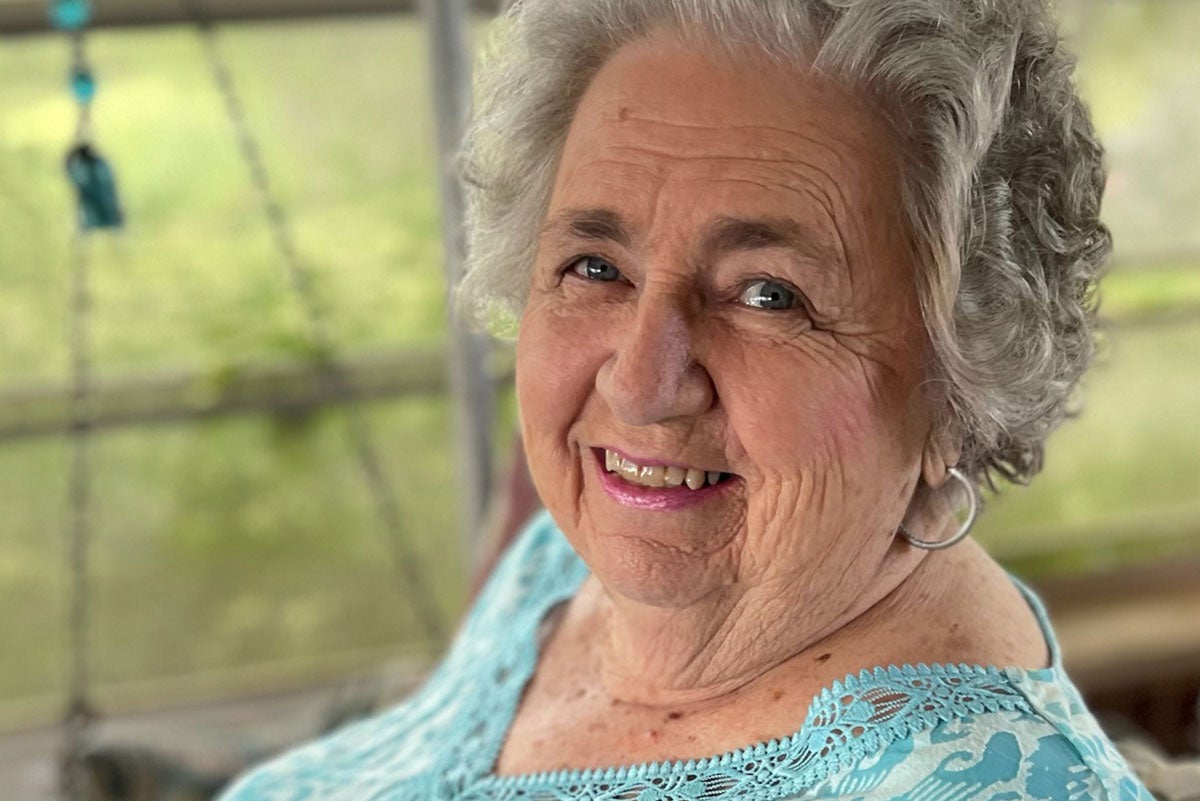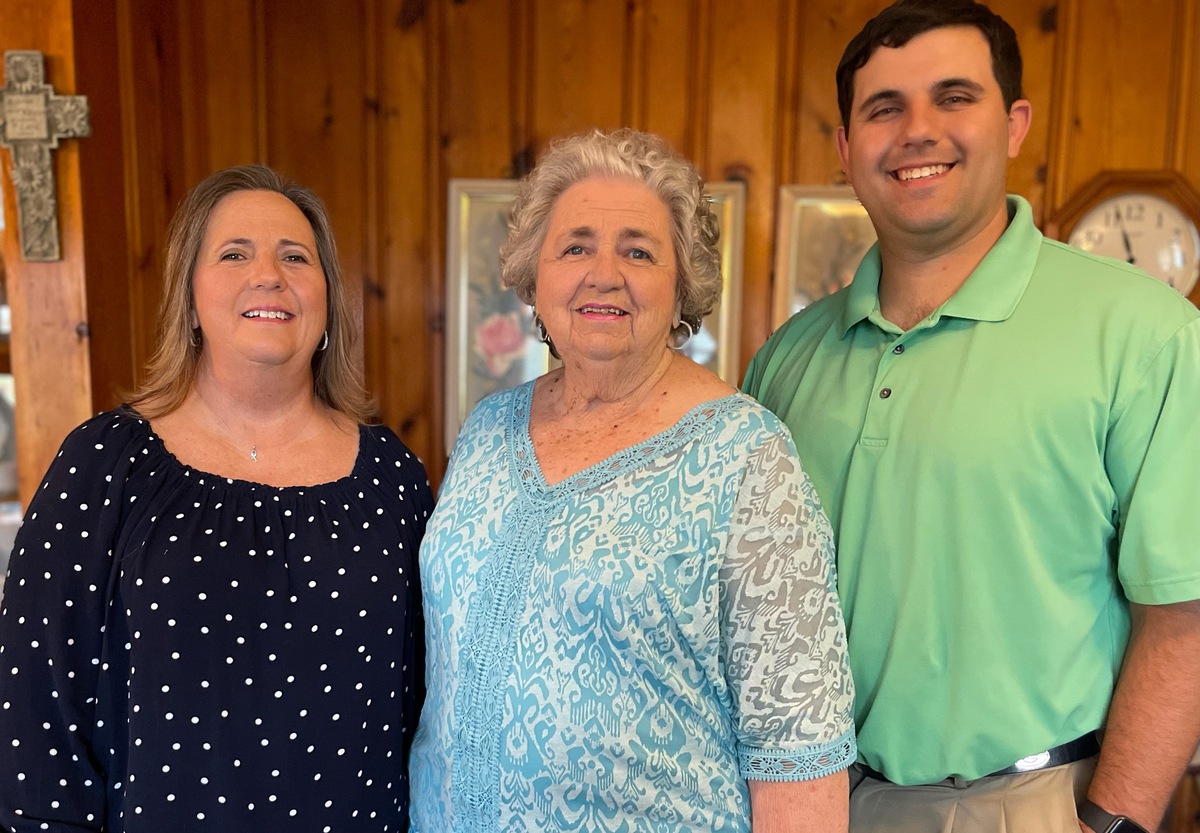Miraculous Recovery: St. Mary’s Stops Diane’s Paralyzing Stroke In Its Tracks
May 16, 2022
By: Mark Ralston
Categories: Patient Stories
May is National Stroke Awareness Month
Tina Cheek and her extended family were gathering for dinner at Tina’s Franklin County home on Thursday, Jan. 27, a few days after Tina’s 10th chemotherapy treatment for colon cancer. As they waited for a few more family members to arrive, they talked and laughed.
Among them was Tina’s 78-year-old mother, Diane Fowler, who lived next door. Despite early stages of dementia, she was laughing and carrying on with the best of them.
And then, from the corner of her eye, Tina noticed her mother’s mouth droop.
“I asked her, ‘Do you feel OK?’” Tina says. “When she answered, her words were slurred. I could barely understand her.”
As a 30-year veteran of St. Mary’s Clinical Laboratory, Tina instantly knew something was wrong, and she had a pretty good idea what it was: stroke. She called 911.
When signs of stroke strike, act fast
A stroke is like a heart attack in the brain. A sudden problem in a blood vessel – such as a blood clot getting stuck or a tear in a blood vessel wall – interrupts blood flow to part of the brain. With no blood flow bringing oxygen and nutrients, brain cells in the affected area become stressed and start to die – up to 2 million of them per minute. And as cells stop functioning, the person starts losing the functions those cells control, including such basic things as how to walk, talk, or even swallow.
It took Franklin County EMS only 9 minutes to arrive, but in that short time, Diane lost nearly all use of the left side of her body. The family worked to keep her safe and comfortable, but it was evident this was a catastrophic stroke, one that could very well take her life or leave half her body paralyzed.
Knowing St. Mary’s is the only hospital in Northeast Georgia that has the ability to physically remove the large-vessel blood clots that cause some of the most severe strokes, Tina asked Franklin EMS to rush her mother to the Athens hospital. They did, calling in advance as they drove south.
The moment Diane reached St. Mary’s, she was met by a friendly face: her grandson Garrett, who is a charge nurse in the ED. He and his team quickly got her to the CT scanner. Tina arrived soon after, praying that the images would show no internal bleeding. If there was no bleeding, her mother might be able to receive the drug tPA, which can dissolve blood clots and restore blood flow.
The scans showed no bleeding. Just 22 minutes after coming through St. Mary’s doors, Diane started receiving tPA.
A higher level of care
On call that evening was Dr. Feroze Afzal, an interventional and vascular neurologist with Georgia Neurological Surgery. He looked at Diane’s CT images and diagnosed that her stroke was caused by a large vessel occlusion. This means that a blood clot had gotten stuck in one of the biggest blood vessels serving her brain. tPA is a wonder drug, but it has its limits. In the time it would take tPA to dissolve the blood clot, Diane would suffer permanent brain damage. She needed a surgical intervention, and fast, before millions of stressed brain cells died.
Diane was taken to St. Mary’s Interventional Radiology Suite, where she was met by Dr. Afzal and St. Mary’s IR team. Using state-of-the-art neurointerventional biplane technology, they removed the blood clot causing her stroke.
How does it work?
The procedure is called mechanical thrombectomy (“thrawm-BECK-toe-ME”). It uses thin, flexible tubes called catheters. A small opening is made into a blood vessel in the upper leg. With x-ray guidance, the surgeon carefully threads the catheter through the inside of blood vessels until it reaches the blockage. Then a special device captures and removes the blood clot.
“Mechanical thrombectomy makes the removal of large vessel occlusions possible,” Dr. Afzal says. “We could not safely go through the skull and then deep inside brain tissue to access and remove a blood clot. The surgery itself would cause as much harm as the stroke. Mechanical thrombectomy allows us to remove the blood clot and restore perfusion without damaging delicate brain tissue.”
St. Mary’s recently became the first hospital in Georgia to be certified by the Joint Commission in this life-saving procedure.
‘It was miraculous’
Diane’s “door-to-reperfusion time” – the time between arrival at St. Mary’s and the restoration of blood flow – was 105 minutes. After the procedure, she was taken to St. Mary’s Neurosciences Critical Care Unit, where highly specialized nurses could keep a close watch for signs of trouble. Her night was blessedly uneventful. The next day was devoted to mandatory bed rest.
The day after that, Jan. 29, Diane’s progress was reassessed by the full care team, including physical, occupational and speech therapy. Less than two days after she lost all use of half her body, she stood up from bed and walked. She could talk. She could swallow. She could use both hands.
She could go home.
“It was a miraculous recovery,” Tina says. “We, as a family, are extremely grateful that she was able to have the thrombectomy. Her stroke would have been devastating – catastrophic – without it.”
Tina is keenly aware the results could have been different. Had her mother been home alone when the stroke struck, it might have been several hours before anyone knew she had collapsed. By then, the damage would have been done: too many brain cells would have died. And once the cells die, nothing can bring them back.
“That’s why you have to call 911 as soon as symptoms appear,” Tina says. “In our case, it was just a God thing that she was where she was and we witnessed it happen.”
Today, it’s like Diane never had a stroke. Tina has finished her chemo and has been pronounced cancer-free – a remarkable story in its own right – and she and her husband have moved in with Diane to help keep her safe as her dementia slowly progresses.
“The stroke just highlighted that it’s no longer safe for her to live alone,” Tina says. “We’re blessed that our family can be with her so she can stay in her own home. We’re blessed that she’s OK after her stroke. Everybody did a great job, from Franklin County EMS to the Emergency Department to Dr. Afzal to the team on NCCU. We are so grateful.”

Stroke survivor Diane Fowler with her daughter, Tina Cheek, and grandson, Garrett Cheek at home in Franklin County. Tina and Garrett helped rush Diane to care when stroke symptoms suddenly appeared.
BE FAST
Stroke happens suddenly. BE FAST is an easy way to remember signs of stroke and what to do if you spot them:
- Balance – trouble with balance or coordination
- Eye – blurred, double or lost vision
- Face – mouth drooping, smile uneven
- Arm – weakness, no feeling, no motion
- Speech – slurred, garbled or not making sense
- Time – Call to 911!



